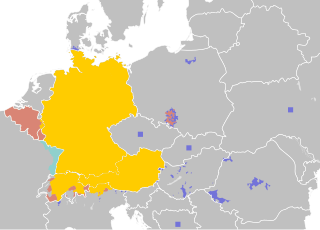
Austrian German, Austrian Standard German (ASG), Standard Austrian German, Austrian High German, or simply just Austrian, is the variety of Standard German written and spoken in Austria and South Tyrol. It has the highest sociolinguistic prestige locally, as it is the variation used in the media and for other formal situations. In less formal situations, Austrians use Bavarian and Alemannic dialects, which are traditionally spoken but rarely written in Austria. It has been standardized with the publishing of the Österreichisches Wörterbuch in 1951.

German is a West Germanic language in the Indo-European language family, mainly spoken in Western and Central Europe. It is the most widely spoken and official or co-official language in Germany, Austria, Switzerland, Liechtenstein, and the Italian province of South Tyrol. It is also an official language of Luxembourg and Belgium, as well as a recognized national language in Namibia. There further exist notable German-speaking communities in France (Alsace), the Czech Republic, Poland, Slovakia, Denmark, Romania and Hungary (Sopron).

The German diaspora consists of German people and their descendants who live outside of Germany. The term is used in particular to refer to the aspects of migration of German speakers from Central Europe to different countries around the world. This definition describes the "German" term as a sociolinguistic group as opposed to the national one since the emigrant groups came from different regions with diverse cultural practices and different varieties of German. For instance, the Alsatians and Hessians were often simply called "Germans" once they set foot in their new homelands.
Standard High German (SHG), less precisely Standard German or High German, is the umbrella term for the standardized varieties of the German language, which are used in formal contexts and for communication between different dialect areas. German is a pluricentric Dachsprache with currently three codified specific national varieties: German Standard German, Austrian Standard German and Swiss Standard German.
Hunsrik, also called Riograndenser Hunsrückisch or Katharinensisch, is a Moselle Franconian language derived primarily from the Hunsrückisch dialect of West Central German which is spoken in parts of South America. A co-official language in the Brazilian municipalities of Antônio Carlos, Santa Maria do Herval, and São João do Oeste, Hunsrik is spoken in the states of Rio Grande do Sul, Santa Catarina, and Paraná, as well as some regions of neighboring Paraguay and Argentina. It has been an integral part of the historical and cultural heritage of the Brazilian state of Rio Grande do Sul since 2012, and considered an intangible cultural heritage of Santa Catarina state since 2016.
A minority language is a language spoken by a minority of the population of a territory. Such people are termed linguistic minorities or language minorities. With a total number of 196 sovereign states recognized internationally and an estimated number of roughly 5,000 to 7,000 languages spoken worldwide, the vast majority of languages are minority languages in every country in which they are spoken. Some minority languages are simultaneously also official languages, such as Irish in Ireland or the numerous indigenous languages of Bolivia. Likewise, some national languages are often considered minority languages, insofar as they are the national language of a stateless nation.
A regional language is a language spoken in a region of a sovereign state, whether it be a small area, a federated state or province or some wider area.
This article details the geographical distribution of speakers of the German language, regardless of the legislative status within the countries where it is spoken. In addition to the Germanosphere in Europe, German-speaking minorities are present in many other countries and on all six inhabited continents.
The (Low)German-based varieties spoken by German Brazilians together form a significant minority language in Brazil. "Brazilian German" is strongly influenced by Portuguese and to a lesser extent by Italian dialects as well as indigenous languages. High German and Low Saxon/German dialects and Germanic languages are particularly strong in Brazil's South and Southeast Regions. According to Ethnologue, ca. 3 million people in Brazil speak the Hunsrik Language, 1.5 million speak Standard German.
In linguistics, a sprachraum is a geographical region where a common first language, with dialect varieties, or group of languages is spoken.

Johann Leo Weisgerber was a Lorraine-born German linguist who also specialized in Celtic linguistics. He developed the "organicist" or "relativist" theory that different languages produce different experiences. He was the son of a village teacher who served as a young man in the German army in Flanders, so could not return to his home city. During World War II his pan-Celticist ideology was co-opted to support the German war effort, as did pro-Polish and pro-Czech ideology on the side of the allies.

The official language of Germany is German, with over 95 percent of the country speaking Standard German or a dialect of German as their first language. This figure includes speakers of Northern Low Saxon, a recognized minority or regional language that is not considered separately from Standard German in statistics. Recognized minority languages have official status as well, usually in their respective regions.
Swiss Standard German, or Swiss High German, referred to by the Swiss as Schriftdeutsch, or German: Hochdeutsch, is the written form of one of four official languages in Switzerland, besides French, Italian, and Romansh. It is a variety of Standard German, used in the German-speaking part of Switzerland and in Liechtenstein. It is mainly written, and rather less often spoken.

The Rat für deutsche Rechtschreibung, or RdR, is the main international body regulating Standard High German orthography.
The Federal Union of European Nationalities (FUEN) is an international non-governmental organization (NGO) established in 1949 in conjunction with the formation of the Council of Europe. FUEN is an umbrella organization, and as of 2023, it has more than 100 member organizations representing ethnic, linguistic and national minorities within Europe. FUEN has been instrumental in encouraging the Council of Europe to adopt the European Charter for Regional or Minority Languages and the Framework Convention for the Protection of National Minorities. FUEN was organized to give expression to European cultures and languages that do not possess form as a nation-state. One in seven Europeans are members of such minorities and fifty-three languages are spoken in Europe by such minorities.

The German Hound is a breed of dog originating in Westphalia, a region of Germany. The German Hound is of the scenthound type, used for hunting both large and small game.
Alto Adige is an Italian local daily newspaper, based in Bolzano. It is sold in South Tyrol and since 1999 also in the province of Belluno. Prior to 2000, the newspaper was published with three local editions, for South Tyrol, Trentino and Belluno, when was subdivided with two new local newspapers: Trentino and Corriere delle Alpi.
The German Orthographic Conference of 1901 took place in Berlin from 17 until 19 June 1901. The results of the conference became official in the German Empire in 1902. The standardized German spelling that resulted from the conference was largely based on the Prussian school spelling, but also on the Orthographic Conference of 1876.
The public debate on whether to establish the German language as a national language in the Basic Law arises because the Basic Law contains no such provision, and never has since its entry into force in 1949. Both positions are advocated for by associations, popular demands, numerous politicians and other public figures.







